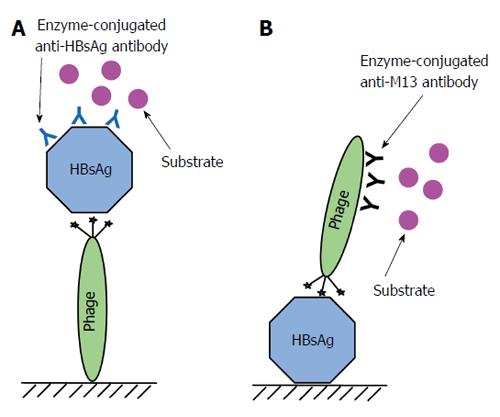Copyright
©2014 Baishideng Publishing Group Inc.
World J Gastroenterol. Sep 7, 2014; 20(33): 11650-11670
Published online Sep 7, 2014. doi: 10.3748/wjg.v20.i33.11650
Published online Sep 7, 2014. doi: 10.3748/wjg.v20.i33.11650
Figure 5 Phage-ELISA for detecting hepatitis B virus surface antigen.
A: Major steps used in an assay for detecting hepatitis B virus surface antigen (HBsAg) by immobilizing phage carrying the peptide on a solid support. The phage harboring the peptide is immobilized on a solid support. The unsaturated area of the solid phase is blocked by 10% milk diluent. The sample containing HBsAg is added to interact with the peptide. Mouse anti-HBsAg antibody is added to interact with the captured HBsAg. Then anti-mouse antibody conjugated to an enzyme is added to interact with the anti-HBsAg antibody. Finally, substrates for the enzyme are added to produce a measurable signal; B: Major steps used in an assay for detecting HBsAg immobilized on a solid support using a phage carrying the peptide. A sample containing HBsAg is immobilized on a solid support. The unsaturated area of the solid phase is blocked by 10% milk diluent. The phage harboring the peptide is added to interact with immobilized HBsAg. Anti-M13 phage antibody conjugated to an enzyme is added to interact with the bound phage and substrates for the enzyme are added to produce a measurable signal. ELISA: Enzyme-Linked Immunosorbent Assay.
- Citation: Tan WS, Ho KL. Phage display creates innovative applications to combat hepatitis B virus. World J Gastroenterol 2014; 20(33): 11650-11670
- URL: https://www.wjgnet.com/1007-9327/full/v20/i33/11650.htm
- DOI: https://dx.doi.org/10.3748/wjg.v20.i33.11650









